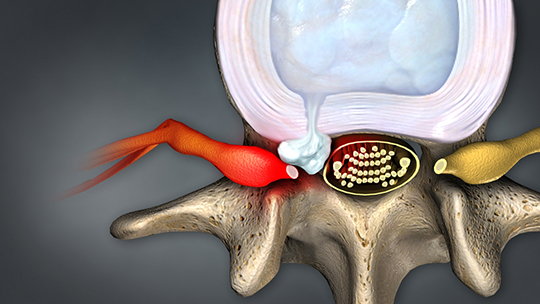On this page:
- •What are slipped or ruptured discs?
- •What are symptoms of a slipped or ruptured disc?
- •What are causes of a slipped or ruptured disc?
- •How is a slipped or ruptured disc diagnosed?
- •Is surgery necessary for a slipped or ruptured disc?
- •What are non-surgical treatment options for a slipped or ruptured disc?
We have 3 convenient locations throughout Southeastern Wisconsin.
What are slipped or ruptured discs?
“Slipped” or “ruptured” discs, often referred to as “herniated discs”, are a common spinal condition affecting one to two percent of all adults with a peak incidence at age 42. This condition is also known as herniated nucleus pulposus (HNP).
A herniated disc occurs when the cartilage shock absorber between the bones of the spine displaces into the spinal canal, causing compression of one of the spinal nerves.
If the outer rim of the disc (also known as the annulus fibrosus) is torn, the disc contents (nucleus pulposus) can press out into the spinal canal. When this happens, a nerve root can be compressed by the disc contents.
What are the symptoms of a slipped or ruptured disc?
Symptoms of a slipped or ruptured disc include:
Back pain:
The specific nerve root affected by the herniated disc will determine the exact area of the symptoms. There may or may not be associated back pain with this condition, known as disc herniation.
Pain in the thigh, calf, or buttocks, or weakness in the ankle:
Symptoms of lumbar disc herniation (in the lower back) include pain that radiates from the back to the buttocks, thigh and calf; numbness or tingling in the thigh and calf; and weakness of the muscles that control ankle function. These may also present for compressed spinal disc symptoms.
Tingling, numbness, or weakness in the neck, arms, or hands:
Cervical disc herniation (in the neck) may cause pain, tingling, numbness or weakness in the neck, arms or hands. In general, disc herniation symptoms often intensify with coughing, sneezing or sitting.
How is a slipped or ruptured disc diagnosed?
Diagnosis may be made with X-rays to rule out other causes, computed tomography (CT or CAT scan), magnetic resonance imaging (MRI) or discogram.
Dr. Ahuja and staff perform radiological procedures at The Brain and Spine Imaging Center, our state-of-the-art imaging facility in Franklin, Wisconsin.
Is surgery necessary for a slipped or ruptured disc?
If a patient is not responding to non-surgical treatment options, surgery may be necessary. Procedures may involve a cervical discectomy, lumbar discectomy, lumbar laminectomy or spinal fusion. Another option that Dr. Ahuja may recommend is a cervical artificial disc replacement such as the Mobi-C® cervical disc.
What are non-surgical treatment options for a slipped or ruptured disc?
Potential non-surgical treatment options for a slipped or ruptured disc include:
- Rest
- Physical therapy
- Medication
- Chiropractic care
- Steroid injections
- Cardiovascular exercise, maintaining a healthy weight, and a regimen to improve strength and flexibility in the area of herniation may help relieve symptoms and prevent muscle spasms in the future.
Call us today for a consultation and we can get you on your way to a pain-free life!



